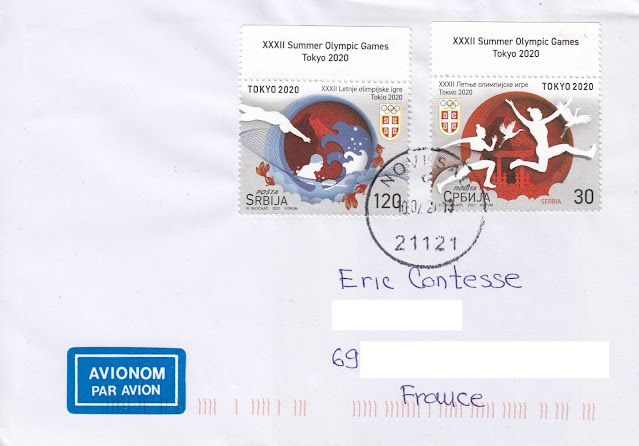Série "Patrimoine culturel rapatrié" sur FDCs de Corée du sud
Une grande partie du patrimoine culturel de la Corée a été exportée illégalement à l'étranger depuis la fin de la dynastie Joseon jusqu'à l'époque de la domination coloniale japonaise et de la guerre de Corée.
Il existe actuellement 193000 éléments du patrimoine culturel coréen dispersés dans 21 pays à travers le monde.
Afin de promouvoir une meilleure compréhension et un meilleur intérêt du public pour la récupération de ce patrimoine culturel à l'étranger, la poste coréenne a mis en circulation, le 26 février 2021, une très jolie série (4 timbres) intitulée "Patrimoine culturel rapatrié", en collaboration avec l'Administration du patrimoine culturel coréen.
Ces 4 timbres (380 won), conçus par Shin Jae-yong et imprimés par Cartor (France)
dans un même feuillet composé de 16 timbres (4 de chaque), figurent sur ce splendide FDC ci-dessous, avec TAD de Nambusan (du 3 mars 2021). Merci beaucoup Ji-Ho !
A noter qu'un vernis spécial a été appliqué sur les différents objets représentés sur ces 4 timbres.
Much of Korea's cultural heritage has been illegally exported overseas from the end of the Joseon Dynasty through the days of Japanese colonial rule and the Korean War.
There are currently 193,000 items of Korean cultural heritage scattered in 21 countries around the world.
In order to promote a better understanding and a better public interest in the recovery of this cultural heritage abroad, the Korean Post released, on February 26, 2021, a very attractive series (4 stamps) entitled "Repatriated cultural heritage", in collaboration with the Korean Cultural Heritage Administration.
These 4 stamps (380 won), designed by Shin Jae-yong and printed by Cartor (France) in a single sheet composed of 16 stamps (4 of each), are present on this splendid FDC below, with cancellations from Nambusan (dated March 3, 2021). Thank you very much Ji-Ho!
To note that a special varnish has been applied to the various objects featured on these 4 stamps.
A noter que cette pagode est représentée en entier dans la marge à gauche de la feuille, présente sur cette lettre.
Gansong Jeon Hyeongpil (1906-1962) qui a dirigé les efforts de collecte et de protection du patrimoine culturel de la Corée, a utilisé son propre argent pour fonder le premier musée moderne de Corée (actuellement le musée d'art de Gansong) et a acquis 20 objets datant de la période Goryeo, en particulier le compte-gouttes en céladon en forme de mère et de bébé singes (trésor national n° 270) reproduit sur le 2ème timbre de cette série.
Le 4ème timbre est consacré à un sceau royal en forme de tortue, rapatrié en Corée grâce à Jo Chang-su (1925-2009), conservateur en charge de l'Asie pendant 44 ans au Smithsonian National Museum of Natural History aux États-Unis. Ce sceau en jade appartenait à l'impératrice Myeongseong (1851-1895).























